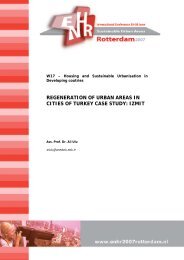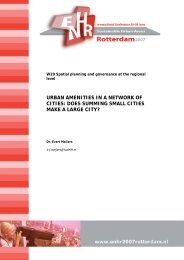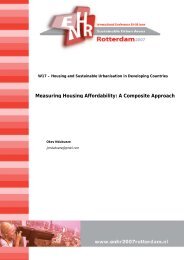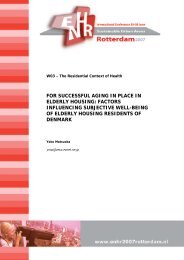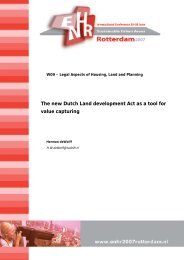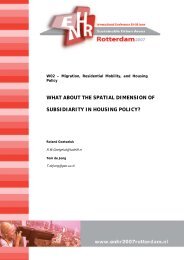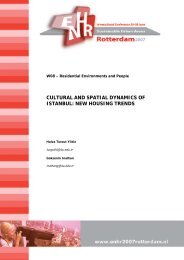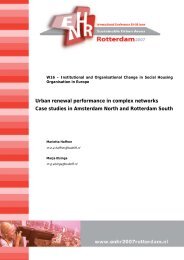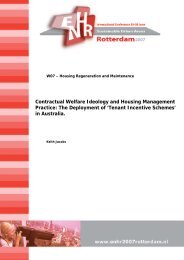Download abstracts - ENHR 2007 Rotterdam
Download abstracts - ENHR 2007 Rotterdam
Download abstracts - ENHR 2007 Rotterdam
You also want an ePaper? Increase the reach of your titles
YUMPU automatically turns print PDFs into web optimized ePapers that Google loves.
Planning for sustainable growth in Melbourne (Australia): Housing affordability and<br />
equity implications of constraints on the planning system<br />
Christian Nygaard 1 // c.a.b.nygaard@reading.ac.uk, Elizabeth Taylor 2<br />
1 University of Reading, Reading, UNITED KINGDOM<br />
2 RMIT University, Melbourne, AUSTRALIA<br />
In 2002 the Victorian State Government launched its strategic plan setting the direction for the<br />
city’s growth over the next three decades ' Melbourne 2030. Important aims of the policy are to<br />
create a more compact city, increase the level of affordable housing across the city and ensure<br />
that the benefits of growth are shared fairly. Densification is promoted on grounds of<br />
environmental and urban sustainability. New housing is, however, primarily the reserve of the<br />
private sector and local government authorities do not have the power to require developers to<br />
provide housing at sub-market rents or prices. The government’s primary lever of influencing<br />
housing standards, location and costs are it’s planning and zoning regulations.<br />
In this paper we examine Melbourne 2030’s affordable housing objectives in light of planning<br />
constraints imposed by private sector investment returns and path dependencies generated by<br />
the existing property stock. We use GIS techniques to integrate unit record property<br />
transactions (re-sales) and rental price data and examine the geography of residential<br />
investment returns and asset appreciation; and analyse housing stock path dependency by<br />
including construction year in hedonic housing prices estimation.<br />
We find that the geography of the investment yield components to some extent are inversely<br />
related and differs between property types. Densification and provision of new housing and<br />
apartment type property may thus add to equity/wealth concerns arising from economic<br />
restructuring and household/demographic change by increasing the value of inelastic<br />
neighbourhood externalities. The geography of residential investment returns may also<br />
contribute to persistent and increasing levels of social segregation and wealth inequality and<br />
impede the government’s affordability objectives. House value depreciation may have a U-<br />
shape, making it less likely that older areas will be redeveloped and/or accessible to lower<br />
income households. Policies objectives such as heritage protection may add to this U-shaped<br />
relationship.<br />
Spatial analysis of housing supply and affordability in metropolitan lagos (comparative<br />
analysis of low cost housing estates)<br />
Fatai Ogundele // kunleoguns@yahoo.co.uk<br />
LASU, Ojo, NIGERIA<br />
The study aimed at studying the level of affordability of public housing to the urban dwellers in<br />
Lagos State Housing Estates with the view to highlight the impediments and proffer possible<br />
solutions.<br />
Four public estates were selected as case study.These are Ogba(medium<br />
income),Adekunle(low income) and Amuwo Odofin(low income).<br />
Asimple random sampling was employed to distribute questionnaires to residents in the<br />
selected estates. The questionnaires sought to determine the level of supply vis-a-vis the ever<br />
increasing population of Lagos being the cpommercial nerve centre of the most populated<br />
Africa nation. It was discovered that the supply was grossly inadequate thus forcing up the<br />
prices of housing in obedience to the lawof demand and supply.<br />
Another objective is to determine the purchasing power of the section of the populatin for<br />
whom the houses were meant for. This was done using the present minimum wage in Lagos<br />
state civil service. The findings were very pathetic. It was found out that a fresh graduate will<br />
have to give up to 50% of his total earning . This to a larger extent gave birth to several<br />
shanties and ghettos in and around Lagos environment.<br />
It is also discovered that most of the original allotees have either sold their apartment outrightly<br />
or have let them tothe present occupant. Facilities in these estates were at different state of



